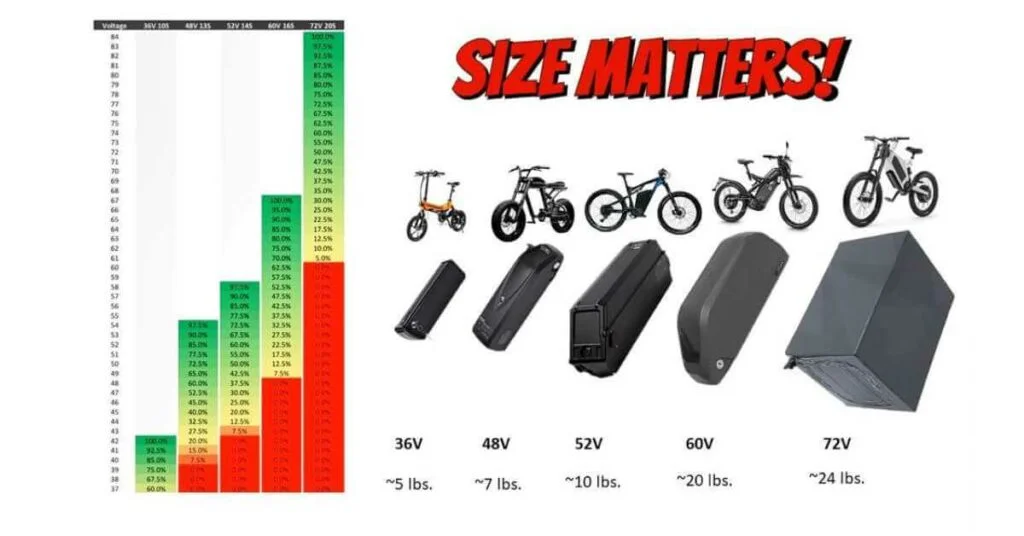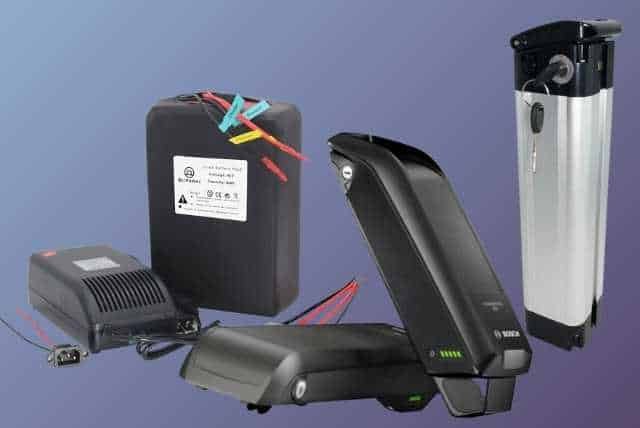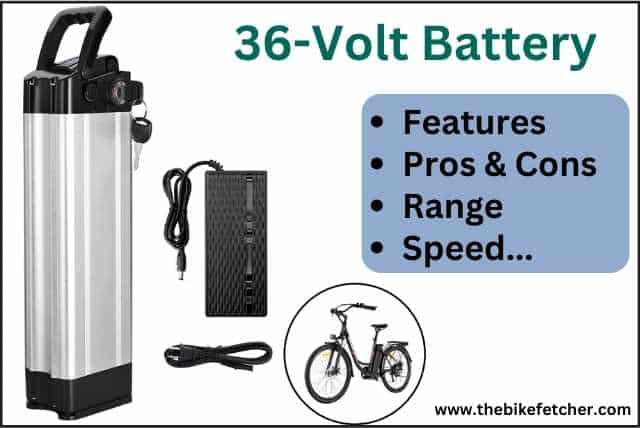Have you ever wondered why some electric bikes outperform others? Well, the secret lies in the reliability and efficiency of the BATTERY, which is the lifeblood of the e-bike.
It is the backbone of the electric power of your e-bike, effortlessly propelling you forward through scenic landscapes.
Likewise, when chosen wisely, a 36V ebike battery’s reliability and efficiency could be a game changer that can take your electric biking journey to the next level.
Therefore, we did our research deeply and have written a comprehensive guide exploring the 36V Ebike Battery range, charging time, cost optimization, and overall performance of your e-bike by understanding the nuances of 36V batteries.
Let’s get started with the basics so that you understand the whole concept easily.
Related: Electric Bike Battery Buying Guide
36V Electric Bike Battery: An Ultimate Guide

We know that when it comes to electric bikes, their battery is the soul and heart of the machine, and it plays a vital role in determining the overall performance. Similarly, one such popular option for an e-bike battery is the 36V one.
The first and foremost question is, What does 36V signify?
“It represents the battery’s voltage, which measures the electric potential difference. One of the best characteristics of a 36V battery is that it is lightweight, and brilliantly balances power & efficiency.”
This makes a 36-volt battery compatible and very popular among e-bike enthusiasts. Moreover, most e-bike systems and motors are designed to work optimally with a 36V battery.
However, to understand the 36V e-bike battery, it is important to look more comprehensively into the factors that form the battery. Hence, let’s dive straight into it.
Significance of Voltage in Ebike Batteries

The significance of the voltage in an electric bike cannot be overstated since it plays a vital role in the performance of the power output and an electric cycle’s capabilities.
Voltage (V) is usually measured in volts and represents the electric potential. Additionally, It determines the strength of the electrical flow allowing the electric bike to reach higher speeds, tackle steeper inclines, and accelerate more quickly.
Furthermore, a higher voltage has the primary advantage of delivering greater torque to the motor, which enables the e-bike to overcome resistance, like hills or rough terrains. This ensures a smoother and more efficient climbing and off-road performance.
However, only battery voltage is not responsible for the overall e-bike’s performance because there are many factors too and they are motor power, controller, battery capacity, and rider’s weight & preferences, etc.
Therefore, you must strike a balance between battery voltage, capacity, and other specifications to match the intended use and riding style. To help you learn more, read this article about the ebike battery sizing guide according to your ebike’s wattage.
36V Electric Bike Battery Voltage Chart
In order to help e-bike enthusiasts understand the voltage, range, and corresponding battery capacity remaining during the rides, we have a voltage chart for a 36V e-bike battery which displays the voltage level at different battery States of Charge (SOC).
Let’s have a look at it!
| Battery Percentage (%) | 36V 10S (Volts) |
|---|---|
| 100 | 42 |
| 90 | 40.8 |
| 80 | 39.6 |
| 70 | 38.4 |
| 60 | 37.2 |
| 50 | 36 |
| 40 | 34.8 |
| 30 | 33.6 |
| 20 | 32.4 |
| 10 | 31.2 |
| 0 | 30 |
You must have noticed one thing in the above voltage chart i.e., Voltage is reducing as the battery’s level is decreasing (why?). It means a 36v battery has 42 volts when it’s 100% charged and 32 volts at 20% charge level.
Please note that the above voltage chart’s values are approximate and could vary depending on the battery’s specifications and usage conditions.
One more important thing is that only voltage does not provide a complete picture of the battery’s remaining capacity and range, factors like ampere hours (AH) and efficiency influence the remaining battery life.
Hence, to accurately determine the battery capacity, we recommend using the battery management system (BMS) or an onboard display that provides real-time battery information, including voltage, capacity, and range estimations.
Pros & Cons of a 36V Ebike Battery
Are you considering a 36V battery for your ebike? But before you make the final decision you must look into the pros and cons as well so that you make a well-informed decision.
PROS:
- Widely available & compatible: One of the major advantages of a 36V e-bike battery is its compatibility factor. This means you have a wide range of options in the market. Hence you can easily find replacements or upgrade your existing e-bike without worrying about compatibility issues.
- Cost-effective: Today, when electric bikes are gaining popularity, it is essential to take cost-effectiveness as a key consideration. That is where 36V e-bike batteries stand out since they are comparatively more affordable than the other higher voltage options. So if you are looking for a cost-effective solution, this makes an attractive offer. Now you can enjoy electric bicycle riding without breaking the bank balance.
- Consumes less energy: 36V e-bike batteries have a good balance between performance and energy consumption; hence they resonate a relatively high energy efficiency. Higher efficiency is a major advantage for a 36v e-bike battery since it can help achieve the appropriate range on a single charge while optimizing energy consumption. Moreover, higher efficiency allows riders to enjoy longer rides without sacrificing battery life.
- Lightweight: Another amazing quality of a 36V e-bike battery is its composition; they are comparatively smaller and lighter than the higher voltage options. This brings in maneuverability, makes it easier to handle, and reduces the riding weight, which is beneficial in various scenarios, such as navigating tight spaces, lifting the bike for transportation, or storing it in limited spaces.
CONS:
- Lacks in high power output: Where a 36V e-bike battery lacks majorly in providing a higher power output, they have limited power, which results in reduced acceleration and top-speed capabilities. Therefore, something other than a 36V may suit you if you are looking for high-performance riding.
- Limited Range: Another drawback of a 36V e-bike battery is its limited range. Where a 36V e-bike battery does offer a respectable range but it may be shorter compared to higher voltage batteries with larger energy capacities. This could be an issue during long-distance journeys with a 36v battery on an electric bike.
- Not recommended for hills: Suppose you frequently ride steeper inclines or rough terrains. In that case, a 36V e-bike battery might need to catch up in providing the necessary torque for utmost performance since they have lower torque capabilities than higher voltage batteries.
I hope you have understood the pros & cons of a 36v ebike battery. I would say look no further if you have a low budget. Because this battery offers enhanced compatibility and affordability. If you are still confused, Read 36v vs 48v ebike battery comparison guide.
Common Types of 36V Battery Chemistries Used in Ebikes

There are various common types of lithium battery chemistries used for 36V batteries that determine the performance, energy density, and overall characteristics of the battery.
Hence, here are some prevalent 36V battery chemistries used in e-bikes!
- Lithium-ion (Li-ion)
- Lithium-ion Phosphate (Li-Po)
- Lithium Manganese Oxide (LMO)
- Lithium Nickel Cobalt Aluminum Oxide (Li-NCA)
Understanding the common types of 36V battery chemistries used in e-bikes is essential for selecting the right battery that aligns with your specific needs and preferences.
Lithium-ion batteries are widely used on electric bikes with different voltages because they are lightweight, last longer, charge faster, and cost-effective. You should opt for this too!
Unlocking 36V Ebike Battery Range, Price & Performance

Take a closer look at the 36V e-bike battery power, range, price, and performance that empowers your ride by pulling back the curtains on the possibilities that a 36V battery can offer.
Hence, let’s uncover the range capabilities and the pricing considerations for efficiently seeking an adventure craving long-distance rides.
Factors affecting the range of a 36-volt Ebike battery
The range of a 36-volt e-bike battery could be influenced by multiple factors, such as:
- The battery’s capacity (Ah) is a major factor since higher-capacity batteries can store more energy and provide longer distances before requiring a recharge, Just like 12Ah vs. 20Ah ebike battery energy capacity.
- Assistance Level is yet another factor because the pedal assist level affects the range by consuming extra battery but not as much as the throttle mode does.
- Riding at high speed holds equal accountability in affecting the range of your 36V e-bike battery. Therefore, riding at a higher speed consumes more energy and reduces the range, whereas maintaining a consistent speed helps optimize the range.
- Furthermore, riding against strong headwinds or windy conditions can increase the aerodynamic drag and energy consumption, reducing the range.
- The rider’s weight also affects the overall range of a 36v battery. If the weight is heavy, it will consume more battery power to propel that extra weight and hence the range is reduced and vice-versa.
Indeed these are some of the most influential factors that drive the range of a 36-volt e-bike battery. Still, apart from these factors, such as temperature, riding style, and efficiency, and trail conditions hold as much importance.
Typical range expectations for different types of e-bikes using 36-volt batteries
36v battery can power any electric bike having a motor with a minimum voltage requirement of 36v volts. I mean, if the motor’s minimum voltage requirement is 48v or above, you can’t use a 36v battery.
During my research, I found that 36v batteries are majorly used in 250w, 350w, and 500w electric bikes. All these ebikes support a 36v battery with different AHs.
Here’s a comprehensive summary of what range you can expect from various e-bikes using a 36v battery.
36V Battery Range With Different AHs on Various Ebikes
| Amp-hours (AH) | 250W Ebike | 350W Ebike | 500W Ebike |
|---|---|---|---|
| 10 | 24-36 miles | 20-30 miles | 18-24 miles |
| 12 | 28-44 miles | 24-36 miles | 22-30 miles |
| 15 | 36-54 miles | 30-45 miles | 27-36 miles |
| 20 | 50-70 miles | 40-60 miles | 48-60 miles |
| 30 | 72-100 miles | 60-90 miles | 54-72 miles |
Calculation of an ebike battery range depends upon two factors i.e., battery capacity and battery consumed at normal speed and fast speed. A higher-wattage ebike consumes more power compared to a lower-wattage ebike.
Similarly, faster ebikes consume more battery power compared to low-speed electric bikes. During my study, I found a 250w ebike with a 36v 10Ah battery consumes 10 Ah per mile at normal speed and 15Ah per mile at fast speed.
Here is the formula to calculate the ebike battery range:
Ebike Battery Range = Battery Watt-Hour/Wh consumed per mile
Expected distance at normal speed = 360 Wh/10 Wh/mile = 36 miles.
Expected distance at fast speed = 360 Wh/15 Wh/mile = 24 miles.
How fast does a 36V electric bike battery go?
We know that the speed of a 36V e-bike battery depends on various factors, including motor power, assistance level, terrain, and other external factors.
In most cases, e-bikes with a 36V battery can reach up to 20-28 mph (32-45 km/h) when using electric motor assistance (350W & 500W).
Moreover, the speed of an e-bike also depends on the motor power and the assistance level chosen. Additionally, the speed achievable with a 36V e-bike battery will vary based on the rider’s pedaling input, weight, riding style, and environmental conditions.
We also highly recommend consulting the manufacturer’s specifications and guidelines for the specific e-bike model. Read our comprehensive article on electric bike’s top speed.
Tips for maximizing the range of a 36-volt battery
We have got you some exclusive tips from some of the most experienced e-bike enthusiasts, so let’s look into those.
- Maintain an optimum level of tire pressure on the ebike. Fill the air pressure at maximum so the wheels roll fast on the roads, hence, the maximum range is achieved.
- Maintain the battery’s health by charging to 80 percent, don’t overcharge as it can damage battery BMS. This will enhance the battery performance and range.
- Don’t apply brakes frequently while riding because braking turns the motor off again and again. This process consumes more battery power therefore, the range decreases.
- Avoid carrying extra weights while riding as the extra weight on the bike forces the motor for more battery power. Hence battery range reduces when the motor consumes more battery for the same distance.
- Don’t charge the battery with a fast charger to save your time as it causes the battery capacity internally. As a result, you get less range.
By implementing these tips, you can optimize your riding habits and maximize the range of your 36-volt e-bike battery, allowing you to enjoy longer rides and extended e-bike adventures.
36V Battery Charging Time and Methods
Charging an e-bike battery efficiently is crucial for uninterrupted rides and optimal performance. If you’re using a 36V battery, understanding its charging time and available methods is essential to keep your e-bike running smoothly and maintain optimal performance.
From conventional overnight charging to rapid charging solutions, let us discuss the various methods available and their impact on charging time.
Overview of charging options for 36V ebike batteries
Understanding the available charging options is essential to keep your 36-volt e-bike battery charged. A fully charged battery is the lifeline of your e-bike adventures, and understanding the range of charging options available for 36-volt e-bike batteries is essential.
Hence, let’s explore some of the charging options we have:
- A Standard Wall Charger is one of the most common and widely preferred chargers by e-bike enthusiasts. It is designed to connect to a standard electrical outlet and is compatible with 36V batteries. Some of its features are a reliable battery charging method and safe charger specifications. The charger can be easily carried to any place as it is lightweight and portable.
- The next is Fast Chargers, specifically designed to reduce the charging time compared to other standard wall chargers. A fast charger is a good option since it utilizes higher charging currents and advanced charging algorithms to speed up the charging process, allowing it to charge a 36V e-bike in a shorter period and get you back on the road more quickly.
- Portable or travel chargers are one of the most compact, making them perfect for portable alternatives. These are convenient for riders since they have the necessary adapters and connectors to work with a 36V e-bike battery.
- On the other hand, Smart Chargers are equipped with advanced charging technology, which drives and adjusts the charging process based on the battery status and conditions. What differentiates these smart chargers is that they have an in-built safety feature for preventing overcharge.
- Lastly, Solar Chargers harness solar energy to charge e-bike batteries by utilizing photovoltaic panels for converting sunlight into electricity which is further used to charge the battery.
While these are indeed sustainable and eco-friendly options, it might be impractical if you are planning your ride in such weather conditions with little sunlight.
Different Charging Times Based on Battery Capacity and Charger Specifications
To ensure a fully charged e-bike battery, it’s crucial to grasp the estimated charging times based on battery capacity and charger specifications.
Whether you’re equipped with a low, medium, or high-capacity battery and using a standard, fast, or rapid charger, let’s provide a concise overview of the typical charging times you can anticipate.
| BATTERY CAPACITY | CHARGER SPECIFICATION | CHARGING TIME |
|---|---|---|
| 36V 10Ah | 2 Amp | 5 hours |
| 36V 10Ah | 3 Amp | 3.5 hours |
| 36V 15Ah | 3 Amp | 5 hours |
| 36V 15Ah | 4 Amp | 4 hours |
| 36V 20Ah | 4 Amp | 5 hours |
| 36V 20Ah | 5 Amp | 4 hours |
| 36V 30Ah | 5 Amp | 6 hours |
As you can see in the above-mentioned chart, when we charge the 36V 10Ah battery with a 2 Amp charger, it takes around 5 hours when the battery’s percentage is around 10-20%.
However, when we charge the same battery with a 3 Amp charger, it takes around 3.5 hours. It means higher Amp chargers take less time to charge the ebike battery and vice-versa.
Learn more about 36v battery charging by reading the detailed article on 36v ebike battery charging time.
Best charging practices to maintain battery health & longevity
Let’s see the most optimal practices you can practice for keeping your e-bike battery in its best working state for a sufficient amount of time.
- Keep your ebike battery clean and dry.
- Charge your e-bike battery regularly.
- Monitor the charging time.
- Avoid any complete discharge.
- Charge at moderate temperatures (10°C to 30°C or 50°F to 86°F ).
- Avoid Overcharging your e-bike battery.
- Always charge the battery with the original charger.
- Don’t overcharge the battery, prefer charging till 80%.
Types of Ebikes Best Suited for 36-Volt Batteries
If you’re in the market for an electric bicycle or bike and considering a 36-volt battery, it’s time to discover the e-bike types that excel with this power source.
When it comes to electric bikes with 36v batteries, it totally depends upon the motor’s voltage & wattage as well as the controller’s capacity.
You should pair a 36v battery with those electric bikes which have 250w motor, 350w motor, and 500w motor (no matter what type of ebike is). Beyond this limit, don’t pair because it would not be able to supply the optimum power.
Let’s unveil the synergy and explore ebike types optimized for 36-volt batteries that offer the best performance.
1. Commuter electric bikes
Designed for everyday urban commuting, prioritizing efficiency and practicality, a 36V e-bike battery is perfectly suitable for maintaining the power and range needed for everyday commuting.
Most commuter electric bikes are powered with 250-watt motors and for such motors, 36v batteries are best (know why) as their speed is limited to 15.5 mph in the UK and 20 mph in the USA.
2. City electric bikes
These are versatile and well-suited for urban navigation featuring a comfortable upright riding position dedicated for shorter to medium-distance rides.
Hence, a 36V battery provides ample power for the same. Also, these ebikes don’t need high-voltage batteries because of their speed limitation.
3. Folding Ebikes
Folding e-bikes are compact and portable and have limited storage space. Hence a 36V battery is a perfect fit due to its small size and lightweight, providing a sufficient power output.
Related topics:
Conclusion
In this comprehensive 36V Ebike Battery Guide, we have explored the crucial aspects of range, charging time, charging cost, performance, and lots of important aspects.
Considering the factors discussed above, you can ensure that your e-bike battery meets your requirements and enhances your riding experience.
As you embark on your e-bike journeys, we hope this guide serves as a valuable resource to ensure that your 36V battery aligns with your needs, providing a seamless and enjoyable ride every time.
Moreover, armed with this knowledge, you can confidently navigate the world of 36V batteries, selecting the right option based on your desired range, charging preferences, budget, and performance expectations.
Frequently Asked Questions (FAQs)
Q1. How far will a 36V 10Ah battery go?
The lifespan of a 36V 10Ah battery can vary depending on usage patterns, terrain, rider weight, and charging practices. A 36V 10Ah battery has a total energy capacity of 360 watt-hours (Wh) (36V x 10Ah = 360Wh).
As a rough estimate, a 36V 10Ah battery can provide a range of approximately 20-50 miles on a single charge.
Q2. How to measure an e-bike battery capacity?
Here are a few simple steps to measure your e-bike’s battery capacity. Start with checking the battery’s rated capacity, then use the battery capacity meter and perform a discharge test, then consider the battery management system for evaluating battery voltage and discharge curves.
Q3. How does the performance of a 36V e-bike battery compare to higher voltage options?
Even though 36V e-bike batteries have limited power output and torque capabilities, which results in reduced acceleration and top speed capabilities, most e-bike enthusiasts still prefer them. It provides sufficient power and performance for everyday riding and commuting.



Greate piece of content on 36v ebike. Keep writing such kind of information on your blog. Im really impressed by your site. I will definitely digg it and in my opinion recommend to my friends. I am sure they will be benefited from this web site.
Thanks for your appreciation! I will be posting more informative articles on electric bikes which are not available on internet.